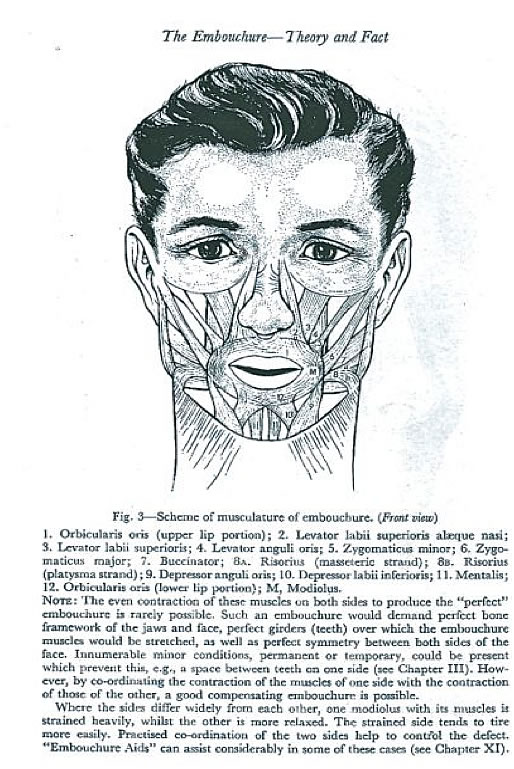An article by Andrew Roberts, May 2012
Many players will have heard air escaping when either blowing or listening to others playing the clarinet. The reason this occurs is because the muscles of the player’s embouchure have not been developed in the right way.
The clarinet is a particularly efficient instrument, which means it will work with less than-ideal technique. This is not possible with less efficient instruments, like the flute. Therefore, flute players generally have to pay a lot more attention to their use of the embouchure muscles. When we actual ly put the mouthpiece into the mouth, the muscles (see diagram) that go around the mouth should be recruited and used in a particular way.
 The reed is the sound generator and, to produce the best sound, needs to rest on a firm bottom lip. Using a mirror to check what you are doing, pull just the very edge of your bottom lip tight over the bottom teeth,(if you use double lip embouchure the top lip covers the upper teeth as well). The chin should be pulling down and flat when looked at from the side. The sides of your mouth should pull into a forced smile, a bit like when you apply lip balm or lipstick.
The reed is the sound generator and, to produce the best sound, needs to rest on a firm bottom lip. Using a mirror to check what you are doing, pull just the very edge of your bottom lip tight over the bottom teeth,(if you use double lip embouchure the top lip covers the upper teeth as well). The chin should be pulling down and flat when looked at from the side. The sides of your mouth should pull into a forced smile, a bit like when you apply lip balm or lipstick.
When this is done make a mouthpiece sized opening between your lips, any more and you will automatically start by biting up and pushing the reed against the mouthpiece, which is a bad thing to do. Biting is the most common problem with many clarinet players, just look at your mouthpiece or patch and see if it is showing marks from your top teeth. The reed must be free to vibrate, the excess pressure from a bite will stop many of the essential vibrations and will compromise your sound, range and dynamic possibilities.
Now try this exercise without blowing, using single lip embouchure, keeping the lower lip pulled tight into an exaggerated smile making a flat chin, slide your top lip up to show your top teeth and gums Next, slide your top lip down onto the mouthpiece keeping the bottom lip firm and the chin flat. Hold this position for 10 seconds and then repeat again 10 times, you can do more of these as the muscles get stronger. This muscle isolation is not easy to achieve at first, so keep checking in the mirror as your old habits will try to move the lower lip and jaw up to make the air tight seal. The muscles are connected but individual control can be developed.
Once you can maintain the firm shape and flat chin start by blowing a small amount of air through the mouthpiece. Make sure, with the mirror, that the muscles of the chin do not come up. If you hear air escaping try to make sure the downward pressure of the top lip is maintained. Do not move your lower lip or jaw up to create the seal!
A further development of this exercise to develop the control and strength of these small muscles is to start with the bottom lip firm and chin flat with a mouthpiece sized opening. Put your little finger just into your mouth like the mouthpiece, and push your top lip down onto your finger. You will have a better sense of the muscles working this way and your brain will find it easier to remember these movements.
Keep the downward pressure of your top lip for 10 seconds and then pull the top lip up in a snarl showing your top teeth and gums! Hold that for 10 seconds and then repeat 5 times to start with gradually building the number of repetitions and length of time you hold the position.
The muscles of the embouchure are small and have a relatively poor blood supply so will tire easily. They should not be worked for too long at a time. Build them up slowly and you will find that your valuable air supply will not be wasted by escaping from the sides of your mouth/embouchure.
If you want further help please contact me at aroberts@theclarinet.co.uk